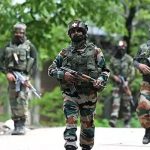Originally published in https://www.thestatesman.com/opinion/karachi-to-kargil-1503463402.html
As India marks 26 years of its triumph in the Kargil War, the time is ripe to look beyond the symbolism of the conflict and examine a disturbing strategic reality ~ Pakistan has systematically weaponised ceasefire agreements not to seek peace, but to perpetuate conflict. From the signing of the Karachi Agreement in 1949 to the most recent ceasefire violations after the Pahalgam terror attack and during Operation Sindoor, Pakistan has turned diplomatic instruments into warfighting tools. These actions are not random violations.
They form a consistent pattern of aggression, deeply rooted in Pakistan’s statecraft, intended to keep India-Pakistan relations in a state of controlled volatility. This strategy serves Pakistan’s internal political, ideological, and military compulsions, and the global community’s silence has only emboldened its actions. In July 1949, following the first Indo-Pak war over Jammu & Kashmir, India and Pakistan signed the Karachi Agreement, which established a ceasefire line to halt hostilities. Supervis – ed by the United Nations Commission for India and Pakistan (UNCIP) and implemented by the United Nations Military Observer Group in India and Pakistan (UNMOGIP), this agreement aimed to stabilise the region.
On paper, the Karachi Agreement looked like a diplomatic success. On the ground, however, Pakistan never truly honoured it. The first major violation came in 1965, through Operation Gibraltar ~ a covert operation where Pakistani soldiers disguised as locals infiltrated into Jammu and Kashmir to incite rebellion. The operation failed and led to the Second Indo-Pak War. Pakistan had ex – ploited the Karachi ceasefire not to maintain peace, but to prepare for another offensive. After the 1971 war, which led to the creation of Bangladesh, the Shimla Agreement of 1972 superseded the Karachi pact and converted the ceasefire line into the Line of Control (LoC).
It emphasised bilateral resolution of disputes and aimed to limit internationalisation of the Kashmir issue. Yet Pakistan has regularly chosen to refer back to the Karachi Agreement ~ which is now legally redundant ~ whenever convenient, particularly in international forums. This selective adherence exposes its double standard diplomatic strategy: uphold agreements that suit its interests while violating those that demand accountability. Even more telling was Pakistan’s attempt to occupy the Siachen Glacier in the early 1980s, claiming that the ceasefire line ended without clarity in the glacier region.
In response, India launched Operation Megh doot to secure strategic heights. This intrusion violated both the Karachi and Shimla agreements, proving again that Pakistan sees formal arrangements merely as instruments to be twisted. In 1999, while diplomatic back channels were active and confidence-building measures were underway, Pakistan once again chose treachery. Soldiers from the Pakistani Army’s Northern Light Infantry, alongside some terrorists, crossed the LoC and occupied strategic heights in the Dras-Kargil-Batalik sector. India responded with force in what became the Kargil War, pushing back the intruders at great human and material cost.
Kargil was not just a military misadventure; it was a stra – tegic betrayal of the Lahore Declaration and the Shimla Agreement. It demonstrated that even formal, bilateral pacts signed in good faith would be dishonoured if Pakistan believed tactical gains were within reach. Since then, Pakistan has continued to violate ceasefires frequently, often through its Special Services Group (SSG) or Border Action Teams (BAT). These teams have carried out brutal ambushes along the LoC, targeting Indian soldiers and mutilating their bodies ~ an affront to military ethics and international norms. Although the Indian Army has responded firmly to such forays by the Pakistani Army, such an attitude and approach will not be acceptable and the response in the next round will be massive and even more telling than Operation Sindoor.
In April 2024, the Pahalgam terror attack once again laid bare Pakistan’s support for cro – ss-border terrorism. What followed were multiple ceasefire violations, even after its own Director General of Military Operations (DGMO) appealed for calm during Operation Sindoor, which was India’s response to increased terrorism in the Valley. This incident revealed a fundamental truth: Pakistan uses cea – sefires as temporary tactical pauses, not as platforms for peace. It manipulates these lulls to infiltrate terrorists, stockpile arms near the LoC, and prepare for the next provocation. The cycle of talks, violations, and posturing continues unchecked ~ because Pakistan thrives on it. Why does Pakistan keep this conflict alive, even as its economy collapses and global sympathy dwindles?
The answer is existential. Kashmir is central to Pakistan’s national identity and military doctrine. Its military elite use the Kashmir issue to justify oversized defence budgets, maintain political dominance, and unite an otherwise fragmented nation against a shared enemy ~ India. In this context, peace is not an objective for Pakistan; perpetual tension is. If the Kashmir dispute were to be resolved or fade into diplomatic irrelevance, Pakistan’s military and political establishment would lose its raison d’être. This is why Pakistan continually seeks to internationalise the Kashmir issue, despite the Shimla Agreement’s clear provision for bilateralism. In the aftermath of the Pahalgam attack, it partnered with China to block references to the Lashkar-e-Taiba-linked The Resistance Front (TRF) in a UNSC resolution condemning the attack.
It also succeeded in pushing a UNSC resolution titled ‘Stren – gthening Mechanisms for Pea – ceful Settlement of Disputes’, a not-so-subtle attempt to reinsert multilateralism into the Kashmir dialogue. Despite all this, the international community ~ especially the West ~ remains silent. Strategic interests in Afghanistan, counter-terrorism cooperation, and fears of nuclear escalation have often led global powers to treat both India and Pakistan as equally responsible actors. They seem to be fixated in hyphenating India with Pakistan. The world’s unwillingness to call out Pakistan’s violations, from Karachi to Kargil to Sindoor, has helped it sustain its shadow war on India. India must remain cleareyed.
Ceasefire agreements with Pakistan are not peace accords; they are temporary frameworks to limit tactical hostilities. They must be honoured ~ but not relied upon blindly. We must maintain strong border infrastructure, enhance surveillance, and invest in intelligence-led counter-infiltration operations. Simultaneously, our diplomatic efforts must expose Pakistan’s duplicity at every global platform ~ from the United Nations to multilateral security forums. India must focus on eternal vigilance, a hardened military posture, and above all, a clear understanding that true peace with Pakistan will remain elusive ~ unless its strategic doctrine undergoes a fundamental shift. Until then, we must prepare not just for the next infiltration or violation ~ but for a resolute and firm response to Pakistan’s misadventure in the future.














